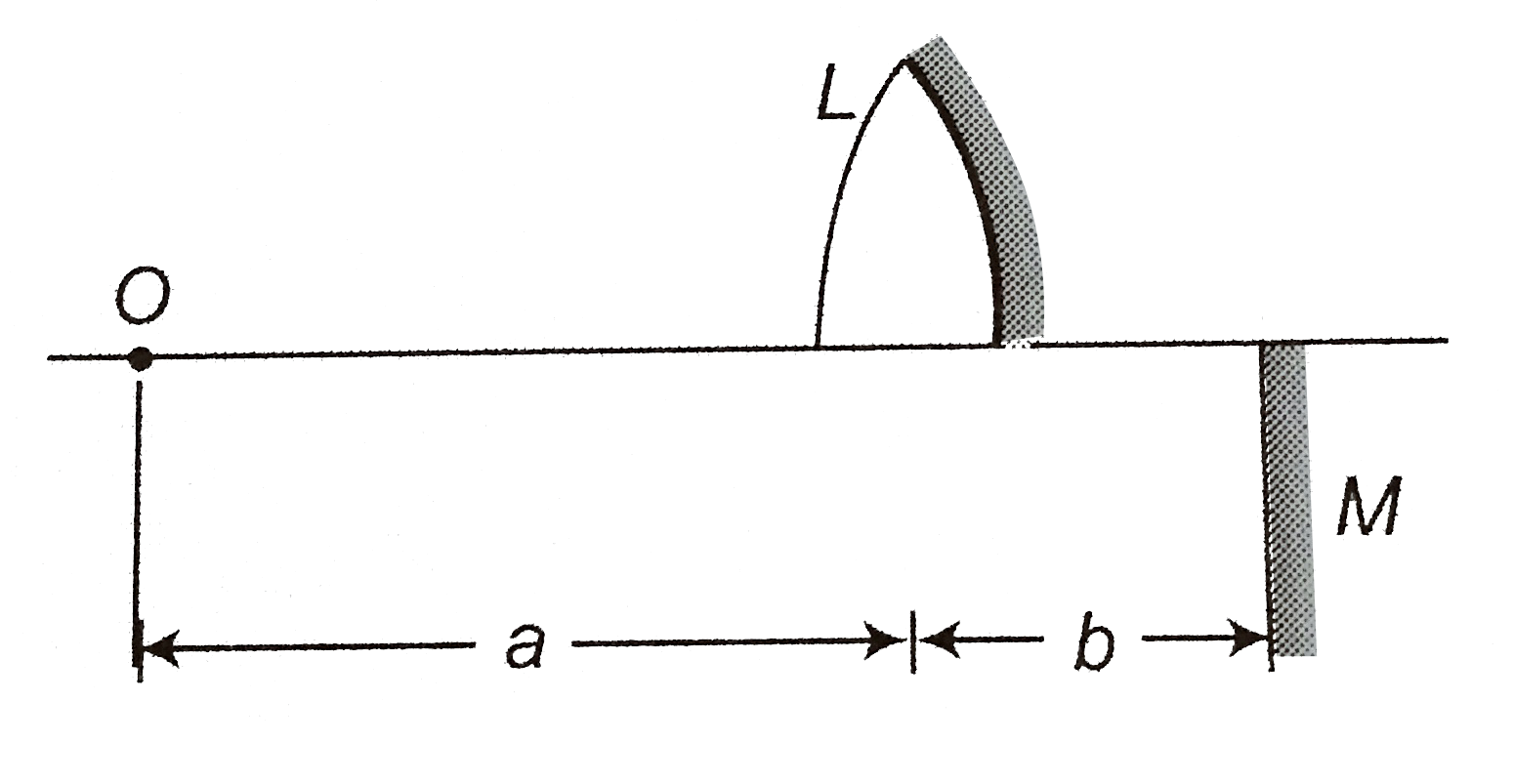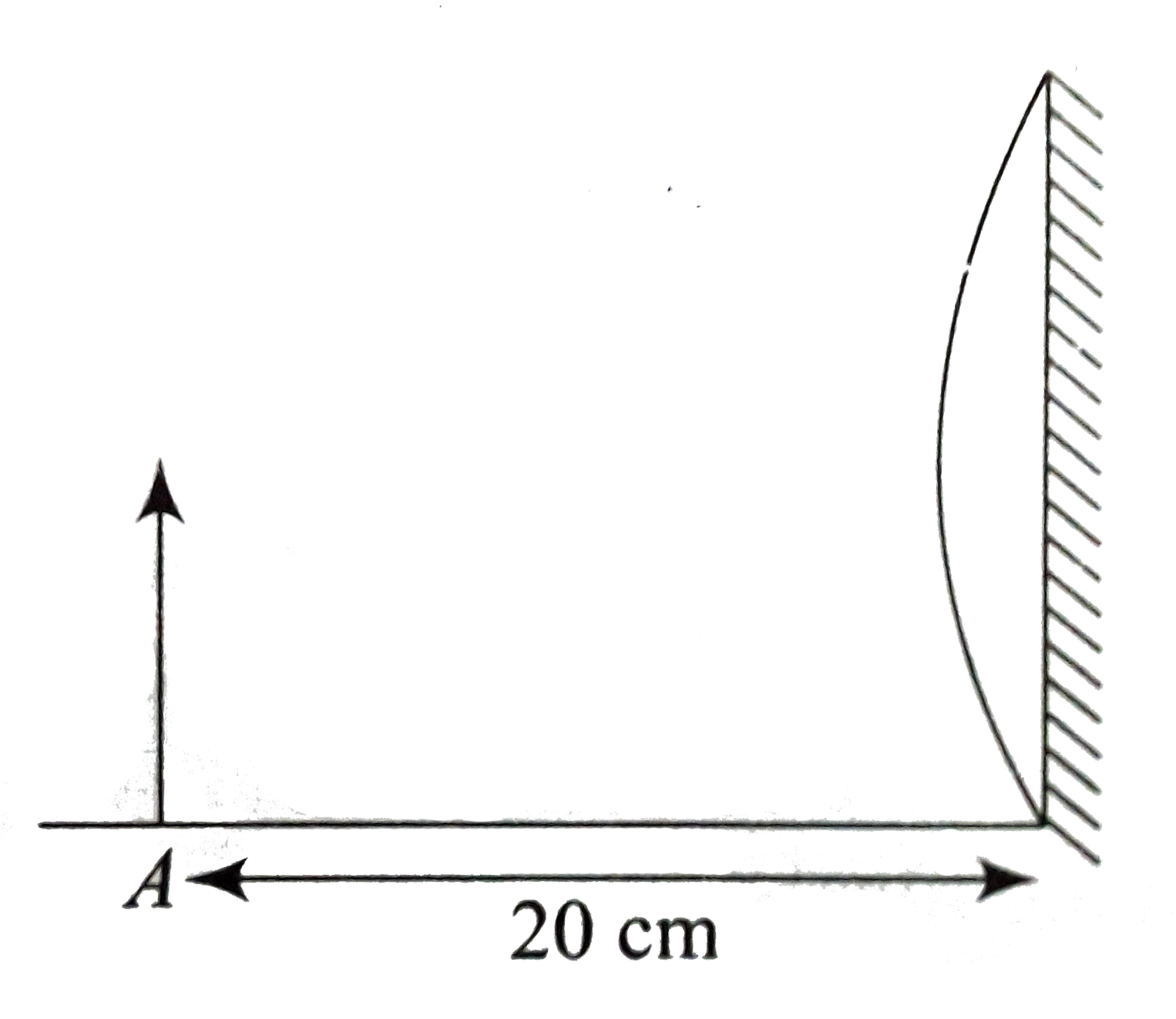
As shown in figure. L is half part of an equiconvex lens (μ=1.5) whose surface have radius of curvature R=40cm and its right surface in silvered. Normal to principal axis, a plane mirror M is placed on the right of lens. A small object O is placed on left of the lens such that there is no parallax between final images formed by the lens and mirror. If transverse length of final image formed by the lens is twice that of image formed by the mirror. Calculate distance a between lens and object and distance b.


First calculate focal length of silvered lens.
1F=1fl+1fm+1fl=2fl+1fm
=2(32−1)(140−1−40)+1402
=120+120=110⇒F=10cm
This silvered lens will behave as a concave mirror of focal length 10 cm.
Image by plane mirror:
Image by silvered lens/concave mirror:
1v+1−a=1−10⇒1v=1a−110=10−a10a
v=10a10−a
m=IO=−vu⇒2=−(10a)/(10−a)−a
10−a=5
a=5cm
v=10a10−a=10×55=10=a+2b⇒10=5+2b
b=2.5cm
Topper's Solved these Questions
- REFRACTION AT SPHERICAL SURFACESBook:CP SINGHChapter:REFRACTION AT SPHERICAL SURFACESExercise:EXERCISES
Explore 105 Videos
- REFLECTION OF LIGHTBook:CP SINGHChapter:REFLECTION OF LIGHTExercise:EXERCISES
Explore 67 Videos
- REFRACTION OF LIGHT BY PLANE SURFACESBook:CP SINGHChapter:REFRACTION OF LIGHT BY PLANE SURFACESExercise:Exercises
Explore 110 Videos
Similar Questions
In figure , L is half part of an equiconvex glass lens (μ=1.5) whose surfaces have radius of curvature R =40cm and its right surface is silvered . Normal to its principal axis a plane mirror M is placed on right of the lens . Distance between lens L and mirror M is b. A small object O is placed on left of the lens such that there is no parallax between final images formed by the lens and mirror. If transverse length of final image formed by lens is twice that of image formed by the mirror , calculate distance'a' in cm between lens and object.
_S01_072_Q01.png)
View SolutionIn figure , L is half part of an equiconvex glass lens (μ=1.5) whose surfaces have radius of curvature R =40cm and its right surface is silvered . Normal to its principal axis a plane mirror M is placed on right of the lens . Distance between lens L and mirror M is b. A small object O is placed on left of the lens such that there is no parallax between final images formed by the lens and mirror. If transverse length of final image formed by lens is twice that of image formed by the mirror , calculate distance'a' in cm between lens and object.
_S01_072_Q01.png)
View Solution
Knowledge Check
An optical system consists of a thin convex lens of focal length 30cm and a plane mirror placed 15cm behind the lens. An object is placed 15cm in front of the lens. The distance of the final image from the object is
A60cmB30cmC75cmD45cmA convex lens of focal length 15 cm is placed on a plane mirror. An object is placed 20 cm from the lens. The image is formed
A12 cm in front of the mirrorB60 cm behind the mirrorC60 cm in front of the mirrorD30 cm in front of the mirrorA convex lens of focal length 15 cm is placed on a plane mirror. An object is placed at 30 cm from the lens. The image is
Areal, at 30 cm in front of the mirrorBreal, at 30 cm behind the mirrorCreal, at 10 cm in front of the mirrorDvirtual, at 10 cm behind the mirror
An optical system consists of a thin convex lens of focal length 30cm and a plane mirror placed 15cm behind the lens. An object is placed 15cm in front of the lens. The distance of the final image from the object is
View SolutionThe optical system consișt of a thin convex lens of focal length 30cmand a plane mirror 15cm behind the lens. An object is placed 15cm in front of the lens. The distance (in cm ) of final image from the lens is
View SolutionA convex lens of focal length 15cm, and a concave mirror of radius of curvature 20cm are placed co-axially 10cm apart. An object is placed in front of convex lens so that there is no parallax between the object and its image formed by the combination. Find the position of the object.
View SolutionA convex lens of focal length 15 cm is placed on a plane mirror. An object is placed at 30 cm from the lens. The image is
View SolutionFocal length of the plano-convex lens is 15cm. A small object is placed at A as shown in figure. The plane surface is silvered. The image will form at

View Solution

